According to internet lore:
"The first recorded case of Alexandria's genesis was a woman named Alexandria Augustine in 1329 London. Her parents, upon realizing her most distinct feature, the purple eyes, decide that she must be possessed and take her to a priest, to have her exorcised. Luckily, the priest had heard of the mutation before and told the parents that nothing was wrong with their daughter. According to legend, after a flash of light over Egypt some odd thousand years ago, the people with purple eyes and very fair skin had appeared only to disappear north and were lost till Alexandria showed up."Alexandria's Genesis is not real - it is a fabrication of author Cameron Aubernon who first wrote about the supposed mutation for a Daria fan fiction. Says Cameron:
"Nearly 15 years ago (circa 1998), I was a huge fan of Daria, MTV's favorite high school cynic. I had also discovered fanfiction then, and when I found some related to my favorite show, I wanted to leave my mark. I just didn't know my mark would be the size of a logic-bomb crater.
On the night of 15 December 2011, something I created under a male pseudonym when I was 19 turned up on my Tumblr dashboard. Something that I made up as a silly backstory for my two Daria-based Mary Sues (fan fiction characters who are "perfect" in every manner possible... and then some). Something that, in turn, was my projection of my personal gender identity and body image issues that I was starting to confront in my 20s.
This something, in the 15 years since I first wrote it, had taken a life of its own. This something was Alexandria's Genesis, a fictional posthuman/alien genetic mutation I created in order to make my Mary Sues more... special.
The short version: Alexandria's Genesis is not, was not, and will never be a real thing; it was a silly little back story for someone's entertaining first draft."
It's not clear to what degree the myth of Alexandria's Genesis may have influenced early depictions of the Emperor's Children in Black Library fiction, but similar imagery has been a popular trope in fantasy, sci-fiction and anime.









































